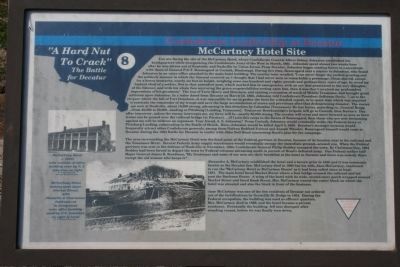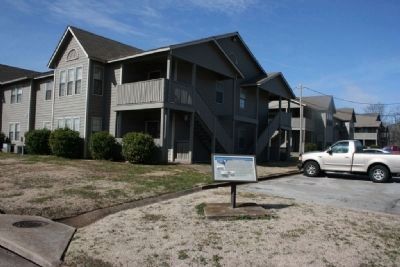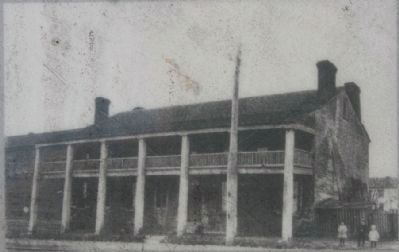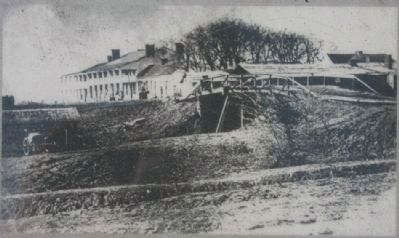Decatur in Morgan County, Alabama — The American South (East South Central)
Confederate Leadership at Decatur - McCartney Hotel Site
“A Hard Nut To Crack”
— The Battle For Decatur —
Inscription.
You are facing the site of the McCartney Hotel, where Confederate General Albert Sidney Johnston established his headquarters while reorganizing the Confederate Army of the West in March, 1862. Johnston spent almost two weeks here after he was driven out of Kentucky and Nashville by Union forces. From Decatur, Johnston began sending forces to concentrate with those of General P.G.T. Beauregard at Corinth, Mississippi. During this time, Beauregard sent a courier to Johnston, who found Johnston in an outer office attached to the main hotel building. The courier later recalled, “I can never forget the cordial greeting and the soldierly manner in which the General received us. I thought that I had never seen so remarkable a personage. Clean-shaved, except for a heavy mustache, nearly six feet in height, weighing some one hundred and eighty pounds and perhaps forty years of age, he stood my highest ideal of a soldier. But in that unstudied pose, which marked him in emergencies, with an eye that penetrated to the very thoughts of the listener, and with his whole face mirroring the grave responsibilities resting upon him, then it was that I received my profoundest impressions of his greatness.” The loss of Forts Henry and Donelson, and ensuing evacuation of much of Middle Tennessee, had brought great criticism upon Johnston. In a
letter dated from Decatur on March 18, 1862, Johnston told Confederate President Jefferson Davis, “…as to the censure which the fall of Fort Donelson…it was impossible for me to gather the facts for a detailed report, or to spare time which was required to extricate the remainder of my troops and save the large accumulation of stores and provisions after that disheartening disaster. The enemy are now at Nashville, about 15,000 strong, advancing in this direction by Columbia [Tennessee]. He has forces, according to…General Bragg …from 25,000 to 50,000...landing at Pittsburg [Landing, Tennessee]. Tomorrow Breckenridge’s brigade will go to Corinth, then Bowen’s. Day after tomorrow, unless the enemy intercepts me, my force will be…nearly 50,000 strong. The cavalry will cross and move forward as soon as their trains can be passed over the railroad bridge [at Decatur]. …If I join this corps to the forces of Beauregard, then those who are now declaiming against me will be without an argument. Your friend, A. S. Johnston.” From Corinth, Johnston would eventually strike the Federal Army at Pittsburg Landing, culminating in the Battle of Shiloh. Here, Johnston would be killed April 6, 1862. Decatur’s strategic location would frequently attract other Confederate generals, among them Nathan Bedford Forrest and Joseph Wheeler. Beauregard himself would come to Decatur during the 1864 Battle for Decatur to confer with John Bell Hood concerning Hood’s plan for the campaign.
The area surrounding the McCartney Hotel was the focal point of the Federal garrison at Decatur, because of its location next to the railroad and the Tennessee River. Several Federal Army supply warehouses would eventually occupy the immediate grounds around you. When the Federal garrison was sent to the defense of Nashville in November, 1864, Confederate General Philip Roddey occupied the town. By Christmas Day, 1864 Roddey had been forced to depart the town by Federal columns advancing south in pursuit of Hood’s defeated army. One Federal soldier told Major General James B. Steedman, “My lieutenant and some of our men ate their breakfast at the hotel in Decatur and there was nobody there except the old woman who keeps it.”
Alexander A. McCartney established the hotel and a tavern prior to 1840 and it was commonly known as the Decatur Inn. McCartney died in 1860 but his wife, Jane McCartney, continued to run the “McCartney Hotel or McCartney House” as it had been called since at least 1851. The main hotel faced Market Street where a foot bridge crossed the railroad and led past the Burleson House. A wing of the hotel with its wide, second-story porch wrapped around Market Street and faced Bank Street. Mrs. McCartney owned the entire block on
which the hotel was situated and also the block in front of the business.
Jane McCartney was one of the few residents of Decatur not ordered out of the fortifications by Grenville M. Dodge in 1864. During the Federal occupation, the building was used as officers’ quarters. Mrs. McCartney died in 1869, and the hotel became a private residence. Eventually the building fell into disrepair after standing vacant, before its was finally torn down.
Erected by City of Decatur. (Marker Number 8.)
Topics. This historical marker is listed in this topic list: War, US Civil. A significant historical month for this entry is March 1862.
Location. 34° 36.905′ N, 86° 58.957′ W. Marker is in Decatur, Alabama, in Morgan County. Marker is at the intersection of Harborview Drive Northeast and Market Street Northwest, on the left when traveling north on Harborview Drive Northeast. Touch for map. Marker is in this post office area: Decatur AL 35602, United States of America. Touch for directions.
Other nearby markers. At least 8 other markers are within walking distance of this marker. Two Bridges Across The Tennessee River (about 300 feet away, measured in a direct line); Hood’s Middle Tennessee Campaign and The Battle for Decatur (about 400 feet away); Decatur and The Civil War in North Alabama (about 400 feet away); Old State Bank Building (about 400 feet away); Battle of Decatur
(about 500 feet away); Rising Sun Lodge No. 29 (about 500 feet away); Gold Star Families Memorial Monument (about 600 feet away); Historic Downtown/Founders Park (about 700 feet away). Touch for a list and map of all markers in Decatur.
Credits. This page was last revised on June 16, 2016. It was originally submitted on March 6, 2010, by Timothy Carr of Birmingham, Alabama. This page has been viewed 2,757 times since then and 65 times this year. Photos: 1, 2, 3, 4. submitted on March 6, 2010, by Timothy Carr of Birmingham, Alabama. • Craig Swain was the editor who published this page.



